
Administrator Harp presented the following awards to recognize the outstanding work of law enforcement personnel and citizens who have made a difference in recovering abducted children and protecting children from exploitation:
Attorney General’s Special Commendation: Detective Lorraine Szczepanik of the Broward County (FL) Sheriff’s Office and the South Florida Internet Crimes Against Children Task Force. Detective Szczepanik’s timely investigation into a person suspected of viewing and sharing child pornography online led to the discovery of thousands of images and videos of child victims, as well as online conversations that led to the identification of three additional child pornographers.
Missing Children’s Law Enforcement Award: Six members of the Round Rock (TX) Police Department, three special agents from the San Antonio FBI Field Office, and a Texas Ranger from Austin collaboratively investigated and tracked down a suspect who kidnapped two missing sisters, ages 7 and 14, from their home in Round Rock. The sisters were found unharmed 700 miles away when the suspect was pulled over following the release of an AMBER Alert and other alerts in Texas, New Mexico, and Colorado.
 “We are here today remembering those sons and daughters, and brothers and sisters who have not come home, and for whom the search will never end,” said Administrator Harp. “Anyone, at any time, can make the difference in the safe recovery of a missing and exploited child.”
“We are here today remembering those sons and daughters, and brothers and sisters who have not come home, and for whom the search will never end,” said Administrator Harp. “Anyone, at any time, can make the difference in the safe recovery of a missing and exploited child.”Missing Children’s Citizen Award: Firefighters Aaron Woods and Michael Webb of the Blount County (TN) Fire Department led a 7-hour portion of a 22-hour search across 2,000 acres of rugged, wooded terrain—on foot and by air—to find a 6-year-old boy and his dog less than 24 hours after they were reported missing.
Missing Children’s Child Protection Award: Detective Christa Hirota and five other members of the Sacramento Valley (CA) High Tech Crimes Task Force led an investigation that resulted in the arrest, only 48 hours after receipt of the initial report, of a foster parent who abused his foster children and produced child pornography.
Administrator Harp announced OJJDP's release of AMBER Alert Field Guide for Law Enforcement Officers. The guide offers recommended practices in key areas of agency response, including the initial on-scene response and investigation, the use of child abduction response teams, and search and recovery operations.
Each year, OJJDP invites fifth graders to participate in the Missing Children's Day poster contest. The annual contest creates an opportunity for schools, law enforcement, and child advocates to discuss the issue of missing and/or exploited children with youth, parents, and guardians and to promote child safety. The winning poster is the inspiration for the National Missing Children's Day poster and artwork for the following year. This year’s winner was Madison Dozier from Reiley Elementary School in Alexandria, KY.
—Yvonne Ambrose
Founder, Desiree Foundation Against Sex Trafficking
Other speakers at the event were Edward C. O’Callaghan, Principal Associate Deputy Attorney General; Matt M. Dummermuth, then-Principal Deputy Assistant Attorney General; Yvonne Ambrose, founder of the Desiree Foundation Against Sex Trafficking; and John F. Clark, President and CEO of the National Center for Missing & Exploited Children (NCMEC).
Supported by OJJDP, NCMEC serves as an information clearinghouse and resource for families—and the professionals who serve them—to help find missing children and prevent child sexual exploitation and victimization. Mr. Clark announced NCMEC’s release of a new music video that automatically updates with photos of children from the NCMEC database that are currently missing in each video viewer’s geographical area.
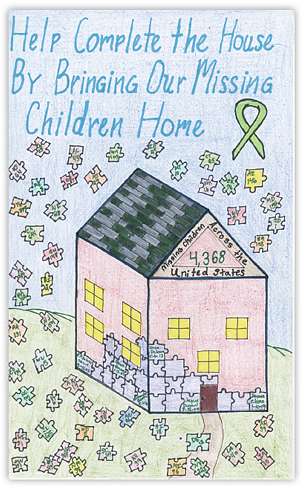 Madison Dozier from Reiley Elementary School in Alexandria, KY, won the 2019 Missing Children's Day poster contest. Her artwork will inspire the poster and artwork for Missing Children's Day next year.
Madison Dozier from Reiley Elementary School in Alexandria, KY, won the 2019 Missing Children's Day poster contest. Her artwork will inspire the poster and artwork for Missing Children's Day next year.OJJDP’s longstanding commitment to finding abducted and missing children includes the Office’s support of the AMBER Alert program. Law enforcement issues AMBER Alerts, which include any available information about the child, abductor, or suspected vehicle used in the abduction, and specify the geographic area where the alert should be disseminated. Once issued, broadcasters and transportation agencies disseminate the alerts. They are also sent to NCMEC, which resends the alerts to a network of secondary distributors that include Internet service providers, wireless carriers, and social media outlets.
In addition, OJJDP works to combat the abuse and sexual exploitation of children through its funding of children’s advocacy centers, the Internet Crimes Against Children task forces, and the National Judicial Institute on Domestic Child Sex Trafficking.
Resources:
To learn more about National Missing Children’s Day and to watch a recording of the ceremony, visit the OJJDP website.
Read OJJDP’s recently released AMBER Alert Best Practices, Second Edition, which provides updated guidelines to help states and regional offices recover abducted children through AMBER Alerts.
Information about the Department of Justice’s National Strategy for Child Exploitation Prevention and Interdiction and Project Safe Childhood is available online.
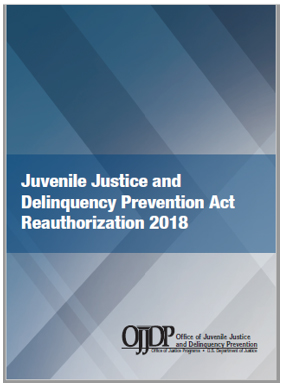 Congress enacted the Juvenile Justice and Delinquency Prevention (JJDP) Act in 1974. This landmark legislation established OJJDP to support local and state efforts to prevent delinquency and improve the juvenile justice system. In December 2018, the Juvenile Justice Reform Act (JJRA) of 2018 was signed into law, reauthorizing and substantially amending the JJDP Act. The JJRA becomes effective on October 1, 2019.
Congress enacted the Juvenile Justice and Delinquency Prevention (JJDP) Act in 1974. This landmark legislation established OJJDP to support local and state efforts to prevent delinquency and improve the juvenile justice system. In December 2018, the Juvenile Justice Reform Act (JJRA) of 2018 was signed into law, reauthorizing and substantially amending the JJDP Act. The JJRA becomes effective on October 1, 2019.
JJRA grants the OJJDP Administrator the authority to increase the minimum allocation to states participating in the Formula Grants program, adds program areas states may support with formula grant funds, and includes new protections for youth who are charged and tried as adults. The Act also adds more stringent requirements for detaining low-level, nonviolent offenders who have violated a court order.
The statute replaces the term “adequate” with “effective” to describe the compliance monitoring universe; however, the statute does not define “effective.” To ensure the safety and well-being of justice-involved youth, OJJDP has seized this opportunity to review what has worked in monitoring facilities and what needs improvement, and will promulgate a rule defining an effective monitoring system.
OJJDP continues to carefully review changes to the legislation, and the Office is committed to sharing implementation resources with the field in a timely manner. The following resources are now available on the OJJDP website:
- The 2018 JJRA redline allows users to closely track changes implemented by the new law.
- A new fact sheet describes the major components of the JJRA, including the effective application date, definition of terms, annual reporting requirements, state allocations, state plan requirements, and the status of funds not allocated due to state noncompliance.
OJJDP will soon make available a video titled “Implementing the Juvenile Justice Reform Act,” which will offer an overview of the key JJRA provisions and OJJDP’s activities to inform the field about JJRA. Additional outreach to inform the field about the JJRA provisions has included an e-blast to more than 20,000 listserv subscribers in January, a webinar for Title II grantees in February, and overviews presented at meetings of the Federal Advisory Committee on Juvenile Justice and the National Association of Counties Legislative Conference in March. OJJDP will continue to inform the field through additional webinars, meetings, conferences, and other activities.
“OJJDP takes its obligation to support the field very seriously, and we are committed to making this transition both simple and successful,” said Administrator Caren Harp. “OJJDP will continue to help states prepare for the changes to this vital program.”
Resources:
View the amended JJDP Act.
Visit the Office’s JJDP Act core requirements compliance webpage.
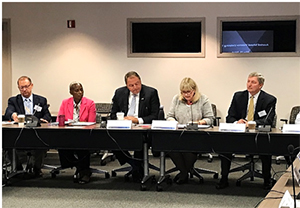 Shown (from left to right) are James Antal, Associate OJJDP Administrator and head of the Office’s Special Victims and Violent Offenders Division; Chyrl Jones, Deputy OJJDP Administrator; James Burch, President of the National Police Foundation; Caren Harp, OJJDP Administrator; and Brad Russ, Director of the National Criminal Justice Training Center.
Shown (from left to right) are James Antal, Associate OJJDP Administrator and head of the Office’s Special Victims and Violent Offenders Division; Chyrl Jones, Deputy OJJDP Administrator; James Burch, President of the National Police Foundation; Caren Harp, OJJDP Administrator; and Brad Russ, Director of the National Criminal Justice Training Center.To address this issue, OJJDP, the National Police Foundation, and the OJJDP-supported National Criminal Justice Training Center (NCJTC) hosted a listening session on May 29, 2019, to explore comprehensive, multidisciplinary approaches to prevent and respond to school violence. The goal is to develop national school safety guidelines and best practices as well as a training curriculum for K–12 urban, rural, tribal, public, private, and charter school stakeholders. Experts in education, law enforcement, school safety, juvenile justice, trauma, and threat assessment training were invited to participate in the session. OJJDP Administrator Caren Harp offered opening remarks.
“Just a few weeks ago on May 7, two students shot and killed one student and injured eight more at the STEM School Highlands Ranch near Denver, Colorado,” said Administrator Harp. “As we know, these incidents of school violence were not the first and will likely not be the last. Our objective today is to identify areas for national policy, best practices, and training. We hope to create a national school safety collection of best practices that answers questions most frequently asked by school stakeholders.”
The session included an overview of the Police Foundation’s Averted School Violence Database. The database is an anonymous, secure, and confidential website where school personnel, law enforcement officers, mental health professionals, and others involved in school safety can share their averted school violence experiences and lessons learned to improve safety and prevent future violence. Information from the database has laid the groundwork for OJJDP to develop trainings through NCJTC and to identify priority school safety issues in need of best-practice guidelines. The session explored a range of these safety issues, including effective crisis planning, the establishment of school conditions that promote prevention and safety, and approaches for addressing students’ behaviors that might be cause for concern.
The national school safety guidelines, best practices, and training curriculum will be highlighted in upcoming webinars and on the OJJDP website.
Resources:
Information about NCJTC’s school safety trainings and the National Police Foundation’s school safety and violence prevention resources is available online.
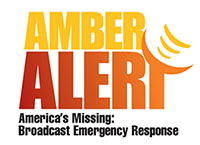 AMBER Alert coordinators, Missing Person Clearinghouse managers, and Child Abduction Response Team members from across the United States, Mexico, and Canada gathered in Scottsdale, AZ, for the National AMBER Alert Symposium on April 16–18, 2019. Attendees participated in training sessions and shared best practices to improve the nation’s response to missing and exploited children. The Office of Justice Programs manages the AMBER Alert Training and Technical Assistance Program with support from OJJDP; in fiscal year 2018, the Office awarded grants to the program totaling $3.4 million.
AMBER Alert coordinators, Missing Person Clearinghouse managers, and Child Abduction Response Team members from across the United States, Mexico, and Canada gathered in Scottsdale, AZ, for the National AMBER Alert Symposium on April 16–18, 2019. Attendees participated in training sessions and shared best practices to improve the nation’s response to missing and exploited children. The Office of Justice Programs manages the AMBER Alert Training and Technical Assistance Program with support from OJJDP; in fiscal year 2018, the Office awarded grants to the program totaling $3.4 million.
Matt M. Dummermuth, then-Principal Deputy Assistant Attorney General for the Office of Justice Programs, offered opening remarks. “The AMBER Alert Training and Technical Assistance Program is our biggest contribution,” he said. “It provides a range of onsite and online training courses that have benefitted nearly 55,000 child protection professionals over the last 5 years.” In addition, Mr. Dummermuth announced OJJDP’s release of the second edition of AMBER Alert Best Practices. The guide is organized around the life cycle of an AMBER Alert and connects best practices to each decision point in the response.
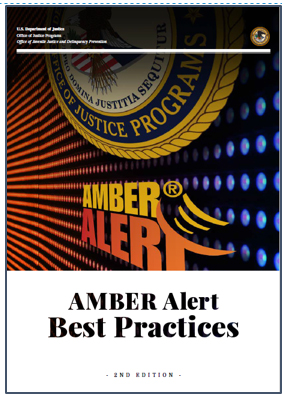 The symposium also included remarks by Elizabeth Strange, First Assistant U.S. Attorney for the District of Arizona, as well as updates from leadership of the National AMBER Alert Training and Technical Assistance Program and the National Center for Missing & Exploited Children. Additional presentations focused on the implementation of the Ashlynne Mike AMBER Alert in Indian Country Act of 2018, AMBER Alert’s Southern Border Initiative, and case studies of cross-border child abduction and international parental child abduction.
The symposium also included remarks by Elizabeth Strange, First Assistant U.S. Attorney for the District of Arizona, as well as updates from leadership of the National AMBER Alert Training and Technical Assistance Program and the National Center for Missing & Exploited Children. Additional presentations focused on the implementation of the Ashlynne Mike AMBER Alert in Indian Country Act of 2018, AMBER Alert’s Southern Border Initiative, and case studies of cross-border child abduction and international parental child abduction.
The AMBER Alert system is being used in all 50 states, the District of Columbia, Puerto Rico, the U.S. Virgin Islands, areas within Indian country, and internationally in 27 countries. As of April 1, 2019, a total of 957 abducted children had been safely recovered through the AMBER Alert system.
Resource:
To learn more about the AMBER Alert Training and Technical Assistance Program, visit the program’s website.
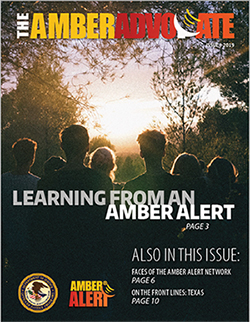 The OJJDP-sponsored AMBER Alert Training and Technical Assistance Program has released a new issue of The AMBER Advocate.
The OJJDP-sponsored AMBER Alert Training and Technical Assistance Program has released a new issue of The AMBER Advocate.
The top story describes how the Northeast Ohio AMBER Alert Committee developed an AMBER Alert Family Response Plan to seek information, feedback, and advice from a victim’s family after a child has been safely recovered. The plan is designed to help improve the AMBER Alert program and offer insights for law enforcement and victim services to more effectively work with families of an abducted child.
The issue also provides updates on AMBER Alert in Indian country, including the launch of the redesigned AMBER Alert in Indian country website. The site offers a comprehensive array of resources, training and technical assistance information, and the latest news about the efforts and outcomes of AMBER Alert in Indian country initiatives.
In addition, “Faces of the AMBER Alert Network” articles feature interviews with AMBER Alert coordinators in New York and Kansas. They share the challenges, successes, and lessons learned from their experiences in recovering missing and abducted children.
The AMBER Advocate is produced through a cooperative agreement with OJJDP.
Resource:
Current and previous issues of The AMBER Advocate are available online.
By Evan Krauss, Director, East Side Aligned
East Side Aligned (ESA), based in East St. Louis (St. Clair County), IL, is a movement involving many sectors of our community in improving the well-being of children and youth and ensuring their readiness for success in school, work, and life. Together, ESA stakeholders strive to align policy, practice, and investment across sectors to achieve our community’s shared goals for young people.
With OJJDP funding, ESA developed the FIRST STOP Plan to Reduce Youth Violence and Victimization. The plan is the result of a process led by the Office of the St. Clair County Board Chairman and the United Way of Greater St. Louis alongside local young people and various community partners. FIRST STOP honors and amplifies the voices of our community to build commitment, civic infrastructure, and leadership so that all children and youth feel—and are—safe. FIRST STOP is shifting mindsets, building trust and collaboration, working to ensure racial equity, and encouraging shared responsibility for youth violence prevention.
At the forefront of FIRST STOP is our goal to build a trauma-informed and responsive community. During the planning process, one resident shared that “hurt people hurt people.” Brain science and research on child development confirm that exposure to violence and trauma can often perpetuate a cycle of harm. Fortunately, healing-centered and evidence-based solutions can mitigate the pervasive consequences of exposure to trauma. Over the last year, we’ve facilitated meaningful progress in transforming how kids are perceived, understood, treated, and served. The impact has been far reaching, yielding change in the settings in which kids live, learn, play, and pray. Following are a few highlights of our recent work:
- Through a partnership between East St. Louis School District 189, East St. Louis Federation of Teachers Local 1220, and the Illinois Federation of Teachers, 500 school personnel participated in a training that explored what trauma is and how it impacts brain development and learning, why educators and stakeholders in education need to acknowledge trauma and its impacts, and how participants can begin to build trauma-informed and responsive schools and communities.
- More than 150 youth development professionals in agencies that run afterschool and summer programs received intensive training on how trauma impacts the adolescent brain, and specific solutions and supports that can be offered through organizations and programs to help young people affected by trauma.
- Two hundred nine stakeholders representing a variety of sectors—including education, law enforcement, social services, and healthcare—received training on trauma and toxic stress. In addition, four area residents were trained on how to take trauma-informed approaches into their neighborhoods; they were then hired to facilitate peer-to-peer trainings.
In addition, 10 institutions—including the state police, the regional probation department, the county prosecutor’s office, the local housing authority and school district, a regional hospital, and several youth-serving agencies—are participating in a year-long Trauma Learning and Action Collaborative, facilitated by Alive and Well Communities. The goal of the collaborative is to reshape policy and practice across systems.
Youth also are learning and taking action. Last summer, about 20 youth participated in training programs focused on community organizing principles, art, civic education, and healing justice. This prompted a group of youth to organize a conference, attended by 50 youth, to share information about the effects of trauma and create a “space” for dialogue on the topic.
All of these efforts are building a shared community understanding of trauma. Together, they are promoting accountability between residents, community agencies, and institutions to ensure that interventions humanize rather than criminalize East St. Louis children and youth. Across the community, the question is changing from “What’s wrong with you?” to “What happened to you?” and “What can we do?”
In combination with other efforts—including an embedded social and emotional learning specialist within the school district, a first-time weapon offender diversion program, and community deescalation and violence-interruption activities—FIRST STOP is changing norms and behaviors, cultivating youth leadership, and creating the conditions to reduce youth violence in the short and long term. We are grateful to have OJJDP’s support, guidance, and investment in our effort to build just systems and create equitable outcomes for youth.
FIRST STOP stakeholders have organized trainings to share healing-centered and evidence-based approaches in school settings to mitigate the effects of exposure to violence and trauma. Shown above are school personnel who participated in a 3-day “train-the-trainer” program and then went on to train more than 500 of their colleagues in East St. Louis School District 189.
 Risk and needs assessments are important tools for improving public safety because they can determine which youth in the juvenile justice system are at the greatest risk of reoffending and identify needs that can be addressed through intervention and services. Yet, these assessments can be challenging to implement, and implementation shortfalls can have a negative impact on system decisions and youth outcomes.
Risk and needs assessments are important tools for improving public safety because they can determine which youth in the juvenile justice system are at the greatest risk of reoffending and identify needs that can be addressed through intervention and services. Yet, these assessments can be challenging to implement, and implementation shortfalls can have a negative impact on system decisions and youth outcomes.
To better understand the factors that may help or hinder effective implementation, in 2015 OJJDP launched a study led by the University of Cincinnati to examine the Ohio Youth Assessment System (OYAS) in three states—Arizona, Indiana, and Ohio. The OYAS measures risk and needs to inform both court decisions and the services that are allocated to youth. Researchers collected data through a variety of methods, including 217 in-person interviews with juvenile justice personnel at 22 agencies, 1,013 web-based surveys, reviews of case record data for 6,222 youth, and phone interviews of 131 youth following their court involvement.
One of the study’s key objectives was to understand how staff perceived the OYAS and implementation of the assessment more broadly. Respondents were generally satisfied with the assessment tool and agreed that the risk and needs assessment benefited their agency and the youth with whom they work, and that the assessment enhanced fairness in the juvenile justice process. However, staff identified areas in need of improvement, including—
- Full implementation of the risk and needs assessment. The agencies used the assessment information to inform supervision levels (e.g., diversion, probation, secure commitment) and establish a baseline to measure youth progress. However, agencies did not use the OYAS to match youth needs to services, share information with outside agencies for treatment purposes, or efficiently allocate agency resources.
- Accuracy and consistency in scoring the assessment. Respondents emphasized a need for more frequent training opportunities and ongoing quality assurance efforts to ensure that staff use the OYAS tools as designed.
- Stakeholder “buy-in.” Because effective implementation of the assessment depends in part on understanding the tool’s usefulness and value, thoughtful approaches to garner support for the tool’s use with both internal and external stakeholders are essential. Respondents recommended that stakeholders become engaged as early as possible and be given a legitimate voice in adopting, implementing, and improving the assessment process.
To evaluate the impact of the OYAS on youth outcomes—including reduced recidivism and other prosocial behaviors and attitudes—the research team analyzed juvenile justice case records and conducted followup interviews with youth. Researchers found that when youth’s risk levels based on the OYAS were used to match youth to supervision levels, the likelihood of recidivism was reduced. However, participation in treatment interventions (e.g., mental health and substance abuse services) was generally not associated with reduced recidivism. The results of the analysis also suggest that matching youth’s needs to treatment based on the scores for “domain areas” within the OYAS (e.g., peers and social support networks, prosocial skills, substance abuse, mental health, and personality) is not occurring consistently. In followup interviews, youth frequently reported being in school or working, regardless of their initial risk level. They also reported receiving treatment during the court process—especially those who were assessed at moderate or higher risk. However, interviewees at all risk levels reported some later contact with police and courts, and also reported drug or alcohol use during the followup.
A major study objective was to develop recommendations for best practices concerning training, monitoring, and use of risk and needs assessments in juvenile justice. The study’s recommendations include sufficient training and post-training support, robust quality assurance practices to ensure the assessment is scored accurately and the information from the assessment is used to its full potential, gaining support for the assessment among a variety of stakeholders, and sharing information with all individuals who will be impacted by its use. Although geared primarily to juvenile justice agencies, these recommendations are relevant to the criminal justice system as well.
Resources:
To access the final report, visit the website of the National Criminal Justice Reference Service. A summary of the study’s preliminary findings is available in the OJJDP bulletin Studying Drivers of Risk and Needs Assessment Instrument Implementation in Juvenile Justice.

United National Indian Tribal Youth Conference: July 4–8, 2019
This conference, organized by United National Indian Tribal Youth (UNITY), will feature dozens of workshops, keynote speakers, and the UNITY College and Career Expo, with more than 60 exhibitors and vendors. The event also includes a cultural night, talent show, 3-on-3 basketball tournament, and the annual UNITY banquet. The conference will take place in Orlando, FL. Registration information is available online.
National Association of Drug Court Professionals Annual Conference: July 14–17, 2019
 The National Association of Drug Court Professionals hosts an annual conference on addiction, mental health, and the justice system. This year, RISE19 will bring together leaders from all models of treatment courts, the recovery community, law enforcement, veteran service organizations, legislators, and other key stakeholders to learn about the latest evidence-based practices for serving individuals with substance use and mental health disorders. The conference will take place in National Harbor, MD. Registration information is available online.
The National Association of Drug Court Professionals hosts an annual conference on addiction, mental health, and the justice system. This year, RISE19 will bring together leaders from all models of treatment courts, the recovery community, law enforcement, veteran service organizations, legislators, and other key stakeholders to learn about the latest evidence-based practices for serving individuals with substance use and mental health disorders. The conference will take place in National Harbor, MD. Registration information is available online.
Child Sex Trafficking Forensic Interview Training: July 15–17, 2019
To be held in Burien, WA, this no-cost training will provide guidance on conducting developmentally appropriate forensic interviews with victims of child sex trafficking. Attendees will learn the differences between interviewing children in child abuse cases and interviewing child sex trafficking victims. This training, sponsored by the National Criminal Justice Training Center, will review a victim-centered interview methodology that emphasizes the factors that contribute to child sex trafficking victimization and the effects of trauma. Registration information is available online. The training will also be held September 11–13 in Plainfield, IN.
Child Abduction Response Team Training: July 23–26, 2019
Offered by the National Criminal Justice Training Center, this no-cost training will discuss the process of developing a multidisciplinary Child Abduction Response Team (CART) for responding to cases of endangered, missing, or abducted children. Topics to be covered include how a child abduction affects families; incident command considerations; search and canvassing operations; CART activation; and resources to improve the response, investigation, search, and canvass activities associated with missing children investigations. The training will be held in Medina, OH. Registration information is available online.
The training will also be held August 5–8 in Grapevine, TX; September 9–12 in Logan, UT; September 16–19 in Marion, OH; and September 23–26 in Salt Lake City, UT.
Emerging Tech: What Are the Current Trends for Teens and Kids?: July 25, 2019
 Presented by the Midwest Regional Children’s Advocacy Center, this webinar will highlight several newer applications for mobile devices that are popular among teenagers. Participants will learn about vault applications and the ability to secretly store information. The webinar will also discuss emerging technological devices and the roles they play in potentially manipulating children. The webinar will be held from 2–3:30 p.m. eastern time. Registration information is available online.
Presented by the Midwest Regional Children’s Advocacy Center, this webinar will highlight several newer applications for mobile devices that are popular among teenagers. Participants will learn about vault applications and the ability to secretly store information. The webinar will also discuss emerging technological devices and the roles they play in potentially manipulating children. The webinar will be held from 2–3:30 p.m. eastern time. Registration information is available online.
National Council of Juvenile and Family Court Judges 82nd Annual Conference: July 28–31, 2019
To be held in Orlando, FL, this conference will address issues facing the juvenile and family court system. Offered by the National Council of Juvenile and Family Court Judges, the event will include topic-specific training tracks on family law, juvenile justice, child welfare, and family violence, as well as tracks featuring practical and innovative solutions to current issues. Registration information is available online.
National AMBER Alert in Indian Country Symposium: July 30–August 1, 2019
Hosted by the OJJDP-sponsored National Criminal Justice Training Center, the theme of this year’s symposium, to be held in Albuquerque, NM, is “Implementing AMBER Alert in Indian Country.” Designed for tribal leaders, public safety and emergency management personnel, and AMBER Alert coordinators, the event will focus on improving the integration of state or regional AMBER Alert communication plans with federally recognized tribes across the nation. Attendees will have the opportunity to collaborate with state, federal, and child protection partners to identify and discuss strategies that will improve tribal communities’ response to missing and exploited children. Registration information is available online.
The Role of the Juvenile Prosecutor: July 31–August 2, 2019
 This new training, to be held in Columbia, SC, will cover a range of topics related to the work of juvenile prosecutors, including child and adolescent development; the prosecution of adolescent sex offender cases; the exploitation and trafficking of minors; serious, violent, and chronic offenders; strategies to address substance abuse in juveniles; and ethical considerations for juvenile prosecutors. OJJDP Administrator Caren Harp will offer opening remarks. The National District Attorneys Association developed the training with support from OJJDP’s National Training and Technical Assistance Center. Juvenile prosecutors from any jurisdiction are welcome. Registration information is available online.
This new training, to be held in Columbia, SC, will cover a range of topics related to the work of juvenile prosecutors, including child and adolescent development; the prosecution of adolescent sex offender cases; the exploitation and trafficking of minors; serious, violent, and chronic offenders; strategies to address substance abuse in juveniles; and ethical considerations for juvenile prosecutors. OJJDP Administrator Caren Harp will offer opening remarks. The National District Attorneys Association developed the training with support from OJJDP’s National Training and Technical Assistance Center. Juvenile prosecutors from any jurisdiction are welcome. Registration information is available online.
Facility Director/Superintendent Training: August 3–6, 2019
The Council of Juvenile Correctional Administrators has developed this new training for administrators of state and local secure juvenile justice facilities. Scheduled to take place in Boston, MA, the training will include presentations and workshops on a range of topics, including best practices in facility supervision, conditions of confinement, gender-responsive care, emergency planning in juvenile facilities, the Juvenile Justice Reform Act of 2018, strategies to maintain safety and security, staff wellness, racial and ethnic disparities, family engagement, and positive youth development. OJJDP provided funding for this training through the Center for Coordinated Assistance to States. As part of a 6-month followup process, participants will develop an improvement plan focused on addressing an emerging issue or challenge facing their facility.
Psychology of School Threat Assessments: August 5–6, 2019
This training, sponsored by the National Criminal Justice Training Center, will examine the psychological and behavioral aspects of threat assessment and management. Attendees will learn how to distinguish between normal versus abnormal child and adolescent behaviors, identify “red flags,” and manage threats to ensure safety. To be held in Omaha, NE, the training will offer multidisciplinary threat assessment and management strategies and explore risk and protective factors for youth violence. Attendees will participate in simulated threat assessments and management. Registration information is available online. The training will also be held September 26–27 in the Denver, CO, area.
Child Homicide Investigations: August 19–20, 2019
This training, offered by the National Criminal Justice Training Center, will focus on understanding and building relationships between the forensic pathologist, homicide investigator, and prosecutor in the investigation and prosecution of child homicide cases. Topics include autopsy protocols, forensic essentials, and the importance of determining the cause and manner of death. Attendees will learn about the unique aspects of investigating a child homicide, which involve interviewing and interrogation, suspect pool development, and the role and importance of the prosecutor in gaining appropriate convictions. The event will take place in the New Orleans, LA, area. Registration information is available online. The training will also be held September 16–17 in Elkhart, IN.
Criminal Connections: Child Pornography and Child Sexual Abuse: August 19–20, 2019
Many offenders who sexually abuse children also possess child pornography. In 2012, more than 80 percent of men arrested for child sexual abuse were in possession of child pornography. During this training, sponsored by the National Criminal Justice Training Center, participants will learn about the additional trauma victims experience when child pornography is involved. To be held in Columbia, SC, the event will explore investigative strategies that address the relationship between child sexual abuse and child pornography to supplement an investigation and corroborate victim statements. Registration information is available online.
Victim Advocacy Training in the Child Advocacy Center: August 27–29, 2019
 Victim advocates in child advocacy centers support children and families by providing crisis intervention, information about the investigation and criminal justice process, and ongoing assistance in connecting families to helpful resources. This training, provided by the National Children’s Advocacy Center, will include sessions on the criminal justice system, the dynamics of child abuse, crisis development and resolution, effective listening techniques, the impact of trauma on children, the rights of crime victims, and intervention strategies. The training will be held in Huntsville, AL. Registration information is available online. The event will also be held October 1–3 in Huntsville.
Victim advocates in child advocacy centers support children and families by providing crisis intervention, information about the investigation and criminal justice process, and ongoing assistance in connecting families to helpful resources. This training, provided by the National Children’s Advocacy Center, will include sessions on the criminal justice system, the dynamics of child abuse, crisis development and resolution, effective listening techniques, the impact of trauma on children, the rights of crime victims, and intervention strategies. The training will be held in Huntsville, AL. Registration information is available online. The event will also be held October 1–3 in Huntsville.
Law Enforcement Investigative Response to Child Sex Trafficking: September 9–11, 2019
This no-cost training, to be held in Pensacola, FL, will offer information and resources to help attendees better understand, recognize, and investigate cases involving child sex trafficking and exploitation. Participants will learn about the dynamics of trafficking and exploitation to improve skills related to interviewing the victim and interrogating the trafficker. The training is offered by the National Criminal Justice Training Center. Registration information is available online.
Initial Response Strategies and Tactics When Responding to Missing Children Incidents: September 13, 2019
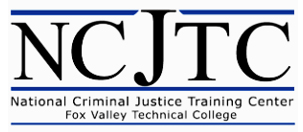 When responding to missing children incidents, accurate and timely situational assessments and the immediate deployment of resources are vitally important. During this training, attendees will learn about the critical steps for first responders to take as they respond to these incidents and how their actions can influence the short- and long-term response of law enforcement. Offered by the National Criminal Justice Training Center, the training will be held in Logan, UT. Registration information is available online.
When responding to missing children incidents, accurate and timely situational assessments and the immediate deployment of resources are vitally important. During this training, attendees will learn about the critical steps for first responders to take as they respond to these incidents and how their actions can influence the short- and long-term response of law enforcement. Offered by the National Criminal Justice Training Center, the training will be held in Logan, UT. Registration information is available online.
Conducting Child Abuse Investigations: September 16–20, 2019
To be held in Wilmington, DE, this no-cost training will provide current information about using a multidisciplinary team approach in the investigation and prosecution of all types of child abuse cases. Participants will learn about medical evidence, interviewing child victims/witnesses and adult suspects/witnesses, and legal issues involved in the investigation and prosecution of child physical and sexual abuse cases. The training is offered by the National Criminal Justice Training Center. Registration information is available online. The training will also be held November 18–22 in Pittsburgh, PA.
State Relations and Assistance Division National Training Conference: September 24–26, 2019
This OJJDP training is designed for staff of designated state agencies and members of state advisory groups. Plans include training and workshops pertinent to the implementation of the Juvenile Justice Reform Act of 2018 and a presentation on federal partnerships between the Department of Health and Human Services and Department of Education. The event, still in the planning stages, will be held in Kansas City, MO. Registration information is available online. Concurrent with the national training conference, OJJDP will convene an in-person meeting of members of the Federal Advisory Committee on Juvenile Justice. Registration information will be available in the coming weeks.
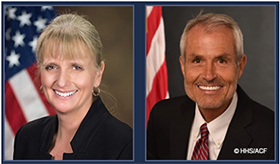
OJJDP and Children’s Bureau Blog and Video Highlight Federal and Local Partnerships To End Child Abuse
In a joint blog and video, OJJDP Administrator Caren Harp and Children's Bureau Associate Commissioner Jerry Milner discuss how both agencies are partnering to promote the safety and well-being of children and families in recognition of National Child Abuse Prevention Month and throughout the year.
The blog and video highlight the efforts of OJJDP and the Children's Bureau to promote community partnerships and support efforts to address and prevent child abuse and neglect.
Administrator To Convene OJJDP Restorative Justice Working Group
Restorative justice encompasses a wide range of practices and approaches that focus on the rehabilitation of offenders through reconciliation with victims and the community at large. These practices have expanded rapidly and now involve multiple models and approaches, including victim-offender conferences; group conferences, which can include family members, friends, and others in the community; and “peacemaking circles,” a process adapted from ancient tribal conflict-resolution rituals. “When properly defined and practiced, restorative justice programs can guide effective youth interventions, repair harm to victims, and enhance public safety,” said OJJDP Administrator Caren Harp. “However, the juvenile justice field generally operates without an agreed-upon definition of restorative justice or a plan for implementation.”
To offer expert assistance to the field, Administrator Harp has organized a working group of leading restorative justice advocates and practitioners. The group will meet several times over the next 2 years, with the goal of producing a user-friendly guide that contains definitions, principles, and implementation guidelines to help jurisdictions gain a better understanding of restorative justice and commit to putting restorative justice programs into action.
The Office has created a mailbox that the public may use to submit comments, suggestions, and ideas on the topic of restorative justice. The feedback may inform the working group discussion and the planned restorative justice guide. A Restorative Justice In Focus webpage that offers information about restorative justice practices, the working group members, and links to helpful resources will be released shortly.
The first meeting of the working group will be held July 15, 2019, at the Office of Justice Programs in Washington, DC. For more information, contact OJJDP.
OJJDP Roundtable: Implementing Systemwide Juvenile Justice Improvements
In 2017, OJJDP launched the Juvenile Justice Systems Improvement Promising Practices Initiative. ICF Incorporated, LLC, received a grant award to synthesize, collect, and interpret the outcomes, models, and best practices of previously funded OJJDP projects. The initiative aims to inform the juvenile justice field about promising practices and lessons learned from the states through roundtable discussions and the development of resources and tools to support states, local governments, and communities in improving outcomes for youth.
As part of the initiative, OJJDP held the second of four expert roundtable discussions at the Office of Justice Programs in Washington, DC, in early April. The discussion focused on OJJDP’s Multicomponent Systems Improvement projects, which have provided training and technical assistance to help states implement legislation mandating changes across the juvenile justice system. The changes are designed to enhance public safety, reduce recidivism, maximize cost savings, and strategically reinvest those savings in juvenile justice programs that have been shown to be effective.
Roundtable discussion participants represented a range of agencies and included OJJDP staff members Gwendolyn Dilworth, Sanzanna Dean, Julia Alanen, and Jeff Slowikowski. Panelists included Rachel Bingham, Executive Director for the Kentucky Administrative Office of the Courts; Susan Burke, Former Director of the Utah Division of Juvenile Services; Ruth Rosenthal, Associate Manager for the Pew Charitable Trusts; and Tessa Upin, Deputy Director of Juvenile Justice Initiatives for the Crime and Justice Institute. These participants, along with ICF’s project team—representatives from Georgetown University’s Center for Juvenile Justice Reform and a seven-member panel of juvenile justice experts—facilitated discussions on how best to lead and sustain multicomponent juvenile justice system improvements in the states.
In group discussions and breakout sessions, participants highlighted why it is important to do the following: create a shared statewide vision for system improvements, explain the reasons for system change, build line staff buy-in, ensure fidelity to evidence-based programs and best practices, engage stakeholders for support, and identify “champions” within organizations to promote systems change. Participants also emphasized the importance of using data to identify areas for system improvement, monitor implementation and progress, and sustain promising practices over time.
The third roundtable, to be held July 9, 2019, will focus on system improvement efforts in the areas of community supervision and the reduction of out-of-home placement for youth. The final roundtable, which will take place October 1, 2019, will discuss legal issues in the juvenile justice system, including the age of criminal responsibility and the full continuum of care required to meet the legal needs of justice-involved youth, from charging to reentry and reintegration.
National Court Appointed Special Advocate Association Holds Annual Conference
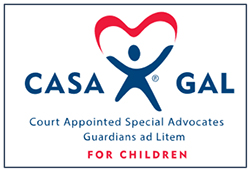 The National Court Appointed Special Advocate (CASA) Association, together with its state and local member programs, supports and promotes court appointed volunteer advocacy on behalf of abused and neglected children. CASA volunteers help ensure that these children do not get lost in the legal or social service systems and that they are placed in safe, permanent homes.
The National Court Appointed Special Advocate (CASA) Association, together with its state and local member programs, supports and promotes court appointed volunteer advocacy on behalf of abused and neglected children. CASA volunteers help ensure that these children do not get lost in the legal or social service systems and that they are placed in safe, permanent homes.
On June 1–4, 2019, staff and volunteers from the association’s network of nearly 950 programs gathered for a national conference in Atlanta, GA. The attendees also included social workers, judges, staff of youth service agencies, researchers, and corporate leaders. The conference theme was “Better Together: Building Stronger Families To Change Children’s Lives.”
The event featured presentations and discussions on a range of topics, including birth-parent and foster-parent partnerships, the intersection of child welfare and immigration, trauma-informed systems of care, the Family First Prevention Services Act, mitigation of the effects of addiction within the family system, support for grandparents who are raising grandchildren, and advocacy for children with incarcerated parents.
“OJJDP is proud to support the CASA model,” said James Antal, head of the Office’s Special Victims and Violent Offenders Division. “CASA volunteers work with legal and child welfare professionals, educators, and service providers to ensure that judges have all the information they need to make the best decisions for each child. They see the child through the entire court process, until the case is closed and the child is in a safe, permanent home.” In 2018, OJJDP supported state and local CASA programs in 49 states and the District of Columbia, and these programs served more than 233,000 abused and neglected children.
Two Programs Rated “Effective” by OJJDP Model Programs Guide
Great Life Mentoring is a one-on-one mentoring program in which youth referred from a community mental health agency receive support from adult volunteers with whom they spend 2–3 hours weekly on positive community activities. The program is rated “effective.” The intervention was shown to be associated with a statistically significant increase in global functioning and a lower likelihood of an unplanned and client-initiated ending of treatment.
Also rated effective is Criando con Amor: Promoviendo Armonía y Superación (CAPAS), a parent-training program forLatino immigrant parents whose children exhibit mild-to-moderate behavioral problems. This program includes two versions of a culturally adapted parenting intervention. Both versions of the intervention were found to have a statistically significant impact on improving parenting practices, compared with the control group. Only the enhanced intervention had a positive, statistically significant effect on child internalizing behaviors. Neither had a statistically significant effect on externalizing behavior.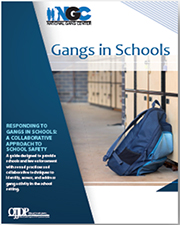
OJJDP’s National Gang Center Releases Gangs in Schools
Gangs in Schools discusses how to create a school safety plan to prevent and disrupt gangs in schools. Developing a comprehensive plan that identifies effective, evidence-based strategies to address gang issues in the school environment requires the involvement of law enforcement, school administrators and staff, and other key sectors of the community.
The OJJDP Comprehensive Gang Model highlights a holistic approach that involves all agencies and organizations within a community that are responsible for addressing gang-related crime and violence. An effective response begins with the coordination of prevention, intervention, and suppression efforts guided by appropriate information-sharing protocols. This establishes shared responsibility for tackling gang-related problems in schools.
All OJJDP publications may be viewed and downloaded on the publications section of the OJJDP website. Print publications may be ordered online at the National Criminal Justice Reference Service website.

 AMBER Alert Best Practices, 2nd Edition
AMBER Alert Best Practices, 2nd Edition
Report
NCJ 252759
This publication is a practical tool for AMBER Alert coordinators and Missing Person Clearinghouse managers. It provides law enforcement and other first responders with online, comprehensive, best-practice recommendations on field operations, including the mapping of key decision points in the life cycle of an AMBER Alert. The guide also describes recent developments in technology and social media, training and readiness, strategic partnerships for governmental and nongovernmental entities, and state-tribal partnerships.
View and download this publication.
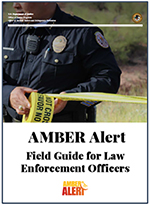
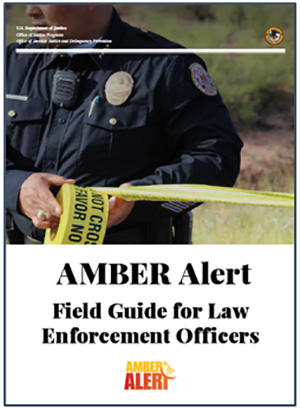 AMBER Alert Field Guide for Law Enforcement Officers
AMBER Alert Field Guide for Law Enforcement Officers
Report
NCJ 252795
This guide was developed by subject-matter experts who have been active in AMBER Alert programs throughout the country. It discusses suggested practices in key areas such as the initial on-scene response and investigation (patrol, supervisory officers, and investigators), the establishment of lead/tip call centers and management of lead/tip information, the use of Child Abduction Response Teams, search and recovery operations, the use of volunteers, officers’ interactions with family members, and the roles and responsibilities of a public information officer.
View and download this publication.
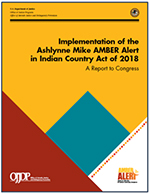
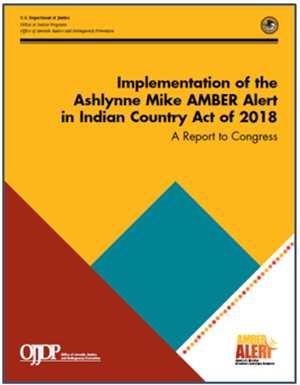 Implementation of the Ashlynne Mike AMBER Alert in Indian Country Act of 2018:
Implementation of the Ashlynne Mike AMBER Alert in Indian Country Act of 2018:
A Report to Congress
NCJ 252671
The Ashlynne Mike AMBER Alert in Indian Country Act of 2018 makes Indian tribes eligible for AMBER Alert grants and permits the use of grant funds to integrate state or regional AMBER Alert communication plans with tribes. This report provides an assessment of the readiness, education and training needs, technological challenges, and obstacles encountered by tribes in the integration of state or regional AMBER Alert communication plans. The assessment consists of two surveys: the National Survey of Federally Recognized Tribes and the National Survey of State AMBER Alert Coordinators. The report’s findings include results from the 100 tribes across 26 states that completed the National Survey of Federally Recognized Tribes and 33 state AMBER Alert coordinators who participated in the National Survey of State AMBER Alert Coordinators.
View and download this publication.
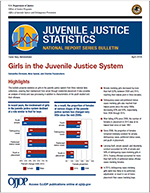
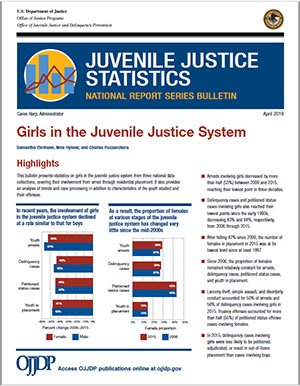 Girls in the Juvenile Justice System
Girls in the Juvenile Justice System
(Bulletin, National Report Series)
NCJ 251486
This bulletin presents a statistical portrait of girls in the juvenile justice system and is drawn from three national data collections: the FBI’s Uniform Crime Reporting Program, OJJDP’s National Juvenile Court Data Archive, and OJJDP’s Census of Juveniles in Residential Placement. From 2006 to 2015, arrests involving girls decreased more than 50 percent, from nearly 580,000 to 269,900. Moreover, the number of delinquency cases, petitioned status cases, and residential placements involving girls were at their lowest levels since the 1990s. However, girls accounted for a relatively large share of arrests for certain types of crimes, such as larceny-theft (40 percent), simple assault (37 percent), and disorderly conduct (35 percent).
View and download this publication.
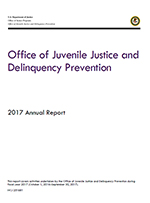
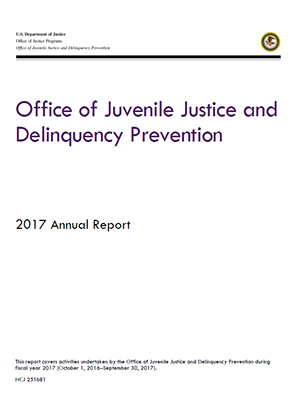 OJJDP 2017 Annual Report
OJJDP 2017 Annual Report
NCJ 251681
This report summarizes OJJDP’s activities during fiscal year 2017 across a range of program areas. The Office awarded nearly $254 million in grants to programs that address juvenile violence, youth gangs, and delinquency. The Office also funded initiatives to protect children from commercial sexual exploitation, sex trafficking, and online predators as well as efforts to reduce substance abuse. Each chapter describes how OJJDP supported research and data collection, provided technical assistance to the field, and shared the latest resources and information to guide system improvement efforts.
View and download this publication.
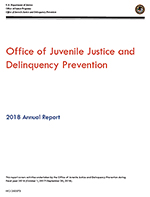
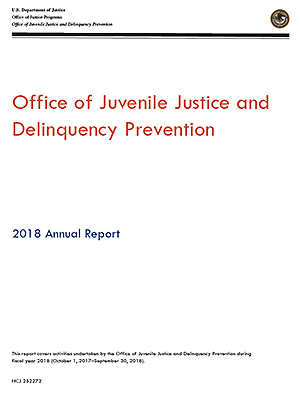 OJJDP 2018 Annual Report
OJJDP 2018 Annual Report
NCJ 252272
In fiscal year 2018, the Office awarded approximately $300 million to fund programs, research, training and technical assistance, and information dissemination activities that enhance public safety, ensure young offenders are held appropriately accountable, and empower youth to live productive, law-abiding lives. Drug use, gang and gun violence, and missing and exploited children are issues of national concern. The report describes OJJDP’s activities to address these and a range of other issues through a diverse portfolio of programs and resources.
View and download this publication.

On June 13, 2019, OJJDP hosted a public meeting of the Coordinating Council on Juvenile Justice and Delinquency Prevention. The meeting highlighted innovative and effective approaches to improve community responses to child abuse and neglect and children’s exposure to violence.
In his introductory remarks, then-Principal Deputy Assistant Attorney General Matt M. Dummermuth said that child abuse “remains an intractable, and serious, problem.” In 2017, an estimated 1,720 children—or about five children per day—died from abuse in the United States. “If kids who are abused and neglected are fortunate enough to escape lasting physical harm, there’s a good chance they will suffer short- and maybe even long-term psychological and emotional injury,” Mr. Dummermuth said.
According to the meeting’s first presenter, Victor Vieth, Director of Education and Research at the Zero Abuse Project and founder of the National Child Protection Training Center (NCPTC), a major gap in addressing child abuse is the lack of quality training available for undergraduate and graduate students who plan to enter professions—such as social work, education, law, medicine, and ministry—where they may encounter cases of child maltreatment.
To address this issue, Winona State University partnered with NCPTC and the National District Attorneys Association to create an intensive, interdisciplinary minor for undergraduates called Child Advocacy Studies Training (CAST).
Shown above at the June 13, 2019, meeting of the Coordinating Council on Juvenile Justice and Delinquency Prevention are Caren Harp, OJJDP Administrator and the Council’s Vice Chair; and Matt M. Dummermuth, then-Principal Deputy Assistant Attorney General, Office of Justice Programs.
CAST educates future professionals to more effectively prevent, identify, and respond to child maltreatment and, among other features, provides students with real-world experience in a classroom setting. The program has been implemented nationally in colleges and universities. CAST programs for graduate students have been established in medical schools, law schools, and seminaries.
The meeting's second presenter, Andrea Darr, Director of the West Virginia Center for Children’s Justice, provided an overview of the center’s implementation of the Handle with Care program, which aims to ensure that children who are exposed to trauma receive appropriate interventions so they can succeed in school to the best of their ability. The program is currently being put into practice in 27 states. 
Handle with Care alerts a child’s school or child care agency that the child was on the scene of a police action in the last 24 hours and was exposed to a traumatic event such as an incident of domestic violence, a shooting in the neighborhood, or a drug raid at the home. Police are trained to identify children at the scene, find out where they go to school or daycare, and send the school or agency an email, text, or fax requesting that the child’s teachers and school staff be on the alert for possible academic, emotional, or behavioral problems.
As part of the center’s pilot program launched at a Charleston, WV, elementary school in 2013, teachers have been trained on the impact of trauma on learning, and are incorporating interventions to mitigate the negative impact of trauma for identified students, including postponing testing, small-group counseling by school counselors, and referrals to external counseling, social service, or advocacy programs. In 2015, West Virginia state police launched Handle with Care programs statewide, Ms. Darr said, and stakeholder meetings are now held in every West Virginia county.
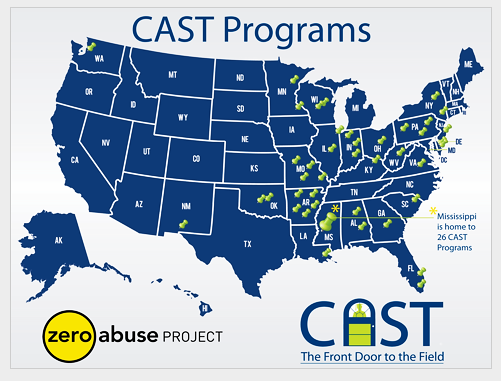
The Coordinating Council on Juvenile Justice and Delinquency Prevention is an independent body within the executive branch of the federal government operated under the Federal Advisory Committee Act. The council's primary functions are to coordinate federal juvenile delinquency prevention programs, federal programs and activities that detain or care for unaccompanied juveniles, and federal programs relating to missing and exploited children.
The council is made up of 22 members—13 ex officio and affiliate members and 9 practitioners. The ex officio members are: the Attorney General; the Administrator of the Office of Juvenile Justice and Delinquency Prevention; the Secretaries of the U.S. Departments of Education, Health and Human Services (HHS), Housing and Urban Development, and Labor; the Assistant Secretary of Immigration and Customs Enforcement in the U.S. Department of Homeland Security; the Director of the Office of National Drug Control Policy; and the Chief Executive Officer of the Corporation for National and Community Service. Affiliate members are the Secretaries of the U.S. Departments of Agriculture, Defense, and the Interior, and the Administrator of the Substance Abuse and Mental Health Services Administration of HHS. The nine juvenile justice practitioner members are appointed by the Speaker of the House of Representatives, the Senate Majority Leader, and the President of the United States. In accordance with the Federal Advisory Committee Act, the Council holds public meetings up to four times a year in which members discuss activities to facilitate and support cross-agency coordination.
